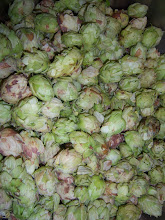We’re already into round two of the Great Saison Chain of Being, and it ain’t even the

New Year yet. And this is the first seasonal saison—
or saisonal, which is a new term I am coining—that will be part of the Great Saison Chain of Being, aka next year’s extended brewing project. I can’t say all saisons all the time, but they’ll be more saisons than you can shake a stick at. And that is quite a few, let me tell you.
164. Saison w/ Juniper Berries
Mash:
6 lbs. MFB Pilsen
3 lbs. Best Malz Spelt
1 lb. Weyermann Acidulated
1 oz. crushed juniper berries
Mash @ 152° F for 90 minutes w/ 3 gallons RO water & 4 g. gypsum; collected almost 2 gallons @ 1.078
Batch sparge @ 163° F for 20 minutes w/ 4 gallons RO water & 2 g. gypsum; collected 4 gallons @ 1.028
Collected 6 gallons; topped off to 7 gallons, brought to a boil (70 minutes), & added:
w/60 to go: 2 ozs. Citra leaf 13.4% AA
w/10 to go: ½ lb. table sugar
1 oz. crushed juniper berries
Chilled & racked onto yeast cake from Wyeast 3726 Farmhouse from
162. Saison w/ Spelt
Primary: 12/24/2013 @ 76° F
Secondary: 1/3/2014 @ 1.010;
added 1 oz. juniper berries
Bottled: 1/31/2014 w/ 4.0 oz.
table sugar
OG: 1.050
FG: 1.006
Tasting Notes (6/17/2014): So I’ve been a bit
negligent in updating many recent beers. I wish I had some compelling
justification to offer, but alas, I do not. Mostly life, and the likes. So on
to the beer! Saison with juniper berries pours a hazy but bright golden straw;
there is an abundant white head that has good retention and laces the glass
nicely. The nose is peppery and spicy with an underlying floral creaminess that
is almost herbal and almost evergreen. As it warms, these do coalesce into a
more distinct juniper aroma, but initially, the juniper is rather hard to pick
out. Flavors follow the nose; the front is dry and crackery on the tongue,
quickly shifting to floral pepper and spice with evergreen and herbal hints in
the middle. There is also some hop bitterness in the middle, and a dry, creamy
spiciness that runs into the finish. Both the body and mouthfeel are dry,
accentuated in part by the bright carbonation and the spicy evergreen. Still,
the floral and creamy elements do hang around, even as the beer warmed. As a
whole, this is a good beer, but not quite what I expected. The juniper is much
less apparent in this beer than I anticipated; while it is there, it blends
almost seamlessly with the yeast and the hops, coming across more as
yeast-derived pepper and spice and/or hop-derived herbal and evergreen flavors
than anything that might definitively be labeled juniper. And it was this way
when I had the first beer as well—it is not like the juniper has been lost
since it was bottled. In one sense, the harmonious marriage here is quite
pleasant; while dry, the beer is balanced and has interesting flavors. On the
other hand, the distinctiveness of the juniper is lost amongst the many other
flavors present in the beer—if you didn’t know you were supposed to be looking
for juniper, it would easily be lost in the shuffle. The juniper does come out
a bit more as the beer warms—halfway through the bottle (which was a 750 ml),
it became more distinctive in the final third of the beer, and even lingered a
bit on the back of the tongue and the throat. As well, while there is residual mouthfeel via the glycerol
production of the yeast, it is certainly drier than some of the other saison
yeasts I’ve experimented with, specifically 3711, which, while dry, always
comes across as more juicy and rounded, even with a lower FG. Maybe the
auxiliary ingredients in this beer (specifically the juniper) have influenced
my perceptions of other elements of this beer as a whole. I’m not certain. What
I do know is this: this yeast warrants more experimentation. While it may take
me a bit to get back to it, I certainly intend to revisit it, as it is worth
understanding this yeast in more detail.
 New Year yet. And this is the first seasonal saison—or saisonal, which is a new term I am coining—that will be part of the Great Saison Chain of Being, aka next year’s extended brewing project. I can’t say all saisons all the time, but they’ll be more saisons than you can shake a stick at. And that is quite a few, let me tell you.
New Year yet. And this is the first seasonal saison—or saisonal, which is a new term I am coining—that will be part of the Great Saison Chain of Being, aka next year’s extended brewing project. I can’t say all saisons all the time, but they’ll be more saisons than you can shake a stick at. And that is quite a few, let me tell you. 
No comments:
Post a Comment